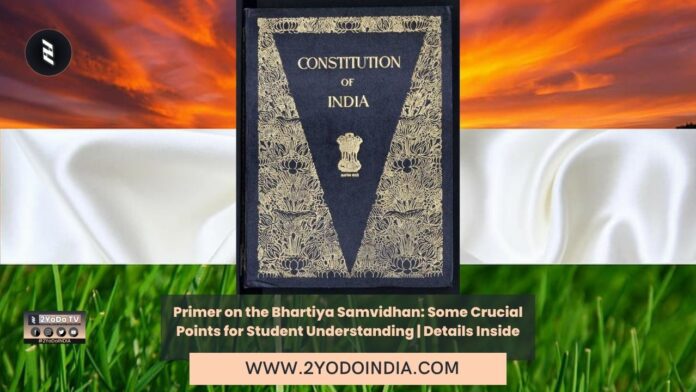Education is the driving factor behind the evolution of every child into a responsible citizen and successful individual to add value to our society, and stream through everyday hurdles with ease.
While subject-specific knowledge plays a important role in shaping a career for any student, there are many other aspect of learning and knowledge that helps the 360-degree of an individual.
As it’s highly essential for one to be arm with a better understanding of everything going around, adapt and respond to diverse scenarios, and most importantly, know our citizenship rights and the legal framework that regulates our native land.
One such important area of learning is the Constitution of India.
A foundational stone to the world’s largest democracy is India, the Indian Constitution has in codes of ethics and conduct across many dimensions.
Today 2YoDo take a quick look down below at some of the key facts about the Constitution of India that every student should know.
Important Facts about The Constitution of India
Constitution Day
The Constituent Assembly adopt the Constitution of India on 26th November, 1949.
The Constitution replace the Government of India Act, 1935, leading up to the foundation of the ‘Republic of India,’ from the ‘Dominion of India.’
The day is celebrated as the ‘Constitution Day of India,’ but, the Constitution came into force on 26th January, 1950, celebrated as the ‘Republic Day.’
It was 26th November, 2015, the 125th birth anniversary of Dr BR Ambedkar, when Constitution Day was first celebrated in India.
Longest Constitution in The World
The Constitution of India is the longest constitution among all sovereign nations in the world.
The Indian Constitution originally pack in about 145,000 words spanning across 395 articles in 22 parts and 8 schedules.
At present though, the Indian Constitution has 448 articles.
The original copy of the constitution which is now preserve inside the library of the Parliament, took around 2 years, 11 months, and 18 days, and was written by hand.
Shaped By Dr. BR Ambedkar
Although the original copy of the Constitution of India was handwritten by renown writer Prem Narayan Raizada, it was Dr BR Ambedkar who craft the final copy of the Constitution of India with key revisions.
It was Dr BR Ambedkar who introduce equal citizen rights for all citizens, and regulations pertaining to women’s rights in the Constitution of India.
Task with the presentation of the final draft of the Constitution, Dr BR Ambedkar made key revisions in the Constitution following suggestions from the Constituent Assembly.
India as Secular and Republic State
Recognising India as a Secular and Democratic state, the Constitution of India upholds democracy in the country.
The term ‘Secular’ underlines that the state of India has no religion and its citizens are free to practice their religion of faith and choice.
The term ‘Republic’ said that India is free from any kind of dictatorship or monarchy, and the state shall be led by elect representatives every 5 years.
Combination of Provisions From Various Countries
The Constitution of India draws many of its provisions from the constitutions of other countries across the world.
Many features of the Constitution of India are either copied or are a modified version of similar provisions present in the constitutions of countries like Great Britain, United States of America, The Soviet Union or Present Russia, South Africa, France, Australia, Japan, Canada, Ireland, and Germany.
Firm Yet Adaptive In Nature
Laying the foundational stone to uphold democracy in India, the Constitution of India has many provisions in place mandating strict adherence and implementation of its key features to ensure peace and order, justice and equality for all, as well as fundamental right to every citizen.
But, the constitution also enables citizens and lawmakers to update outdated laws and provisions in the Constitution through appropriate petitions.
By far, the Constitution of India has amend 106 times, since its adoption in 1950.
Starts With A Preamble
Similar to the Constitution Of The United States, which was the first constitution in the world to start with a preamble, the Indian Constitution also starts with a Preamble.
What sums up as the summary or introduction, the Preamble to the Constitution of India underlines equality, justice, and freedom for all its citizens.
Through the 42nd Constitutional Amendment in 1976, the words ‘Socialist’, ‘Secular,’ and ‘integrity’ to it.
Fundamental Laws
Amongst its list of many provisions and regulations, the Constitution of India also underlines 6 Fundamental Rights entitled to all citizens.
These rights include :
- Right to Equality,
- Right to Freedom,
- Right against Exploitation,
- Right to Freedom of Religion,
- Cultural and Educational Rights,
- Right to Constitutional Remedies.
The Constitution also seamlessly blends fundamental rights with fundamental duties, emphasizing rights with responsibilities.
Fundamental Principles
Besides fundamental rights and key legal provisions, the Constitution of India also underscores some key principles that lay the foundation of the democratic government looking over the country.
These basic principles include :
- Fundamental Rights,
- Secularism,
- Popular Sovereignty,
- Federalism,
- Socialism,
- Judicial Independence,
- Cabinet Government,
- Directive Principles of State Policy.
It’s the Constitution of India that seamlessly demarcates the powers and the functioning boundaries of the Executive, Legislative and Judiciary branches of the State of India.
The power separation is uniquely craft to avoid any additional concentration of power to one branch.
The Constitution also hold a balance between the relationship and synchronized functioning of the Centre as well as different States, and beautifully avoids the overlapping of powers and authority between different departments/wings of the Union and state governments.





